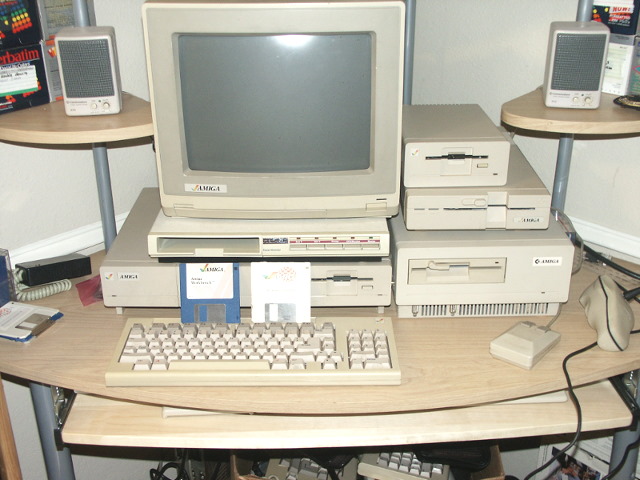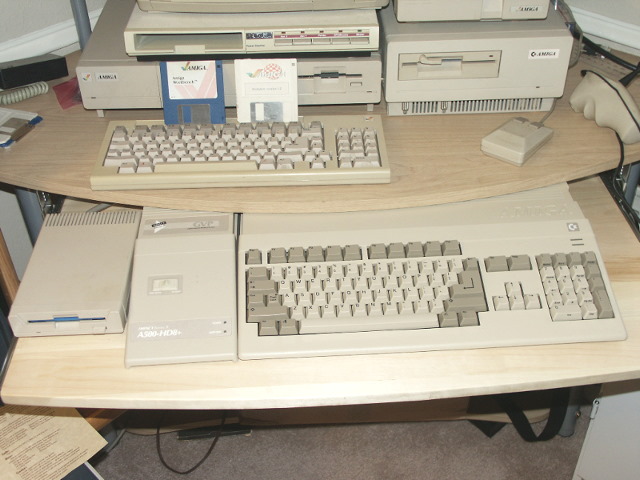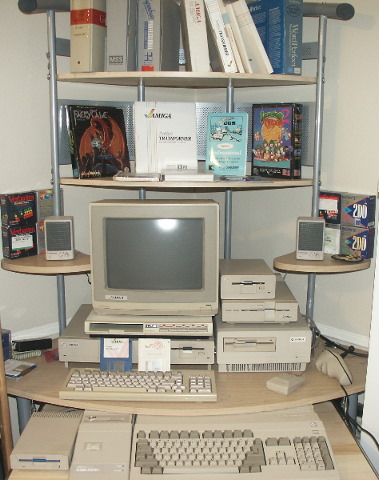|
Amiga 1000/500 |
|||||||||||||||||||||||||
|
 Here's what my A1000 setup looks like. Notice the Sidecar along with the 5.25 " and 3.5" drives. |
||||||||||||||||||||||||
|
The Lorraine Amiga Company was formed to develop the ultimate game machine. As it was being designed, the engineers realized they had the potential for one of the best home computers to be released in years. Early on, they started to run short of money and looked around for someone to go in partners with them and provide a much needed cash infusion. At first, Atari was interested and even advanced them a substantial amount of money, but someone forgot to have Lorraine obligate to Atari. When the money started to run low again, Commodore stepped in and bought the company lock, stock, barrel and computer. Atari promptly filed suit against Commodore. Atari lost. They went on and developed the ST line of computers. When Commodore released the Amiga 1000, it was one of the most powerful home computers to date. It is able to multi-task in only 512K, something Windows still only dreams of. The 1000 sold extremely well to gamers but was never able to successfully move into the business industry. Unfortunately, it is totally non-DOS compatible. Commodore released a software program called Transformer which allowed for DOS emulation in software. It is extremely SLOW, but it does work. Commodore said the Transformer software was just a temporary solution and they would develop a "low cost" hardware solution. The Sidecar was the result at $995.00 The Sidecar is, in effect, a complete XT computer less keyboard and monitor, which plugged into the side of the Amiga. It never really sold well. After the success of the 1000, Commodore went back to the drawing board and decided to "split the Amiga line into 2, one for the consumer and one for the more serious user. The Amiga 500 and 2000 were the result. The 500 was designed to be a home computer with emphasis on gaming. The Zorro bus was still available, as was a "trap door" expansion slot. The trap door was primarily used for memory expansion although there was one instance of a 80286 emulator offered. The Zorro slot offered essentially the same expandability as the 1000. However, the same problem applied to the 500 as it did to the 1000. If you added on more than one item to the side, it started becoming extremely ungainly and long. Fortunately, most expansions for the 500 were multi faceted. A prime example is the GVP A500 HD+8. Not only is there a SCSI hard drive installed, there is also a SCSI port, memory expansion and even a slot for a co-processor, ie 80286. The 500 devolved into the 600 which was the same machine without a numeric keypad and added a PCMCIA slot for expansion. The 500 also evolved into the 1200 which boasted a 68020 processor and more chip RAM. Commodore declared bankruptcy in 1994, sold Amiga to Escom who produced a few 3000's and 4000's and then they went bust also. From the time Commodore went under until the present, there have been around 6-7 owners of the Amiga technology and name, including Gateway!. Currently a company that started as Amino Corp and renamed itself to Amiga Corp. after buying the rights to the Amiga is looking at developing an Amiga that will be faithful to the original OS and based on either a PPC or x86 platform. There have been rumors, but nothing firm has been announced as of this date. Interestingly enough, a laptop was never officially designed by any of the owners. However, a fellow named Simon Archer decided to make one. Using a A600 motherboard, he came up with the Suzanne. Check it out! |
 The Amiga 500 showing its GVP A500HD8+ side car and a low profile 3.5" drive. |
||||||||||||||||||||||||
 The whole Amiga rig. Notice the speakers? They're Amiga A10 speakers. Only thing here that's not Commodore/Amiga is the GVP expansion on the 500 and the power switch controller. |
|||||||||||||||||||||||||